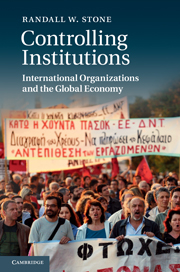Book contents
- Frontmatter
- Contents
- List of figures
- List of tables
- Preface
- List of abbreviations
- 1 Introduction: international organization and US power
- PART ONE THEORY
- 2 A theory of international organization
- 3 A model of informal governance
- PART TWO CASES
- PART THREE HYPOTHESES
- Appendix: additional tables
- References
- Index
3 - A model of informal governance
Published online by Cambridge University Press: 11 April 2011
- Frontmatter
- Contents
- List of figures
- List of tables
- Preface
- List of abbreviations
- 1 Introduction: international organization and US power
- PART ONE THEORY
- 2 A theory of international organization
- 3 A model of informal governance
- PART TWO CASES
- PART THREE HYPOTHESES
- Appendix: additional tables
- References
- Index
Summary
The argument is that international organizations are best understood as equilibrium outcomes that balance the power and interests of the leading state and the member countries. Institutional design is endogenous to this interaction, and includes membership, formal voting rights and informal governance procedures. The model that follows gives specific content to this claim by specifying how three particular forms of power interact. Structural power represents the outside options of the leading state and the externalities that its participation generates for other members. Formal voting rights set the policy of the organization and create the parameters within which informal influence is exercised. Informal influence consists of participation in decision making and special access to information, and it allows the leading state to override the common policy when its vital interests are affected.
Hybrid institutional forms involving both formal and informal governance mechanisms are the norm because they make it possible to accommodate the interests of both strong and weak powers. Informal governance can be legitimate because the degree of conflict of interest between the leading state and the membership varies within the range of issues or cases that fall under an organization's competence, so the member countries tolerate a degree of informal influence in cases of special concern to the leading power in return for a larger share of decision-making authority in ordinary times. This tacit contract depends upon the restraint of the leading state, however, and the legitimacy and credibility of the organization can be eroded if informal influence is used too frequently.
- Type
- Chapter
- Information
- Controlling InstitutionsInternational Organizations and the Global Economy, pp. 33 - 48Publisher: Cambridge University PressPrint publication year: 2011



